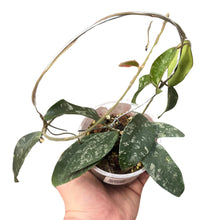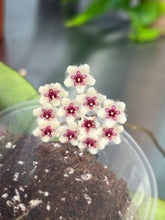9cm potted plant in a coco husk plug with coco coir, coco chips, perlite and pine bark. We do not recommend removing the plant from the coco husk plug.
The plant pictures is an example of the plant you will receive :)
Hoya phuwuaensis is part of the Apocynaceae family and its native range is N. Thailand where it grows as a climbing epiphyte in the wet tropical biome. It is very similar to the widespread and common species H. caudata as both species have prominent mottling of silver spots on the adaxial leaf surface and positively geotropic inflorescences; although this plant is considered easier to grow. Hoya phuwuaensis has woody stems and ruffled leaf margins. Flowers are star-shaped and a creamy colour with a red centre.
Genus name is new Latin, named after Thomas Hoy ( c. 1750– c. 1821), English gardener. Specific epithet honours where this plant was first discovered - in the Phu Wua Wildlife Sanctuary in northeastern Thailand in July 2015.
Pot: ø 9cm.
Light: Bright indirect light, meaning the plant sees the sun for 0-4 hours per day - this could be through trees or a translucent curtain, it’s important for the plant to see the sky in order to thrive. An east-facing window is usually a good spot.
Water: Allow the majority of the mix to dry out as the mix is traditionally quite chunky, water will usually flow through quite easily. Be sure to thoroughly moisten the substrate.
Potting mix: A chunky well draining mix composed of coco coir, perlite or vermiculite, orchid bark, sphagnum moss and worm castings; you could also add some horticultural charcoal to this epiphytic mix. Alternatively, you can pot in a mix of coco chips and perlite.
Fertilising: Feed your plant every few waterings during the growing season or when you observe active growth. You can dilute fertiliser to half the recommended amount but never add more.
Temperature: 15-35°C
Humidity: Hoya prefer higher humidity, between 60-80% - they definitely grow better with higher humidity.
For further information about Hoya, check out our blog.
Hoya aren’t considered toxic, however, they may make your pet or child vomit if ingested, keep out of reach just to be safe.



